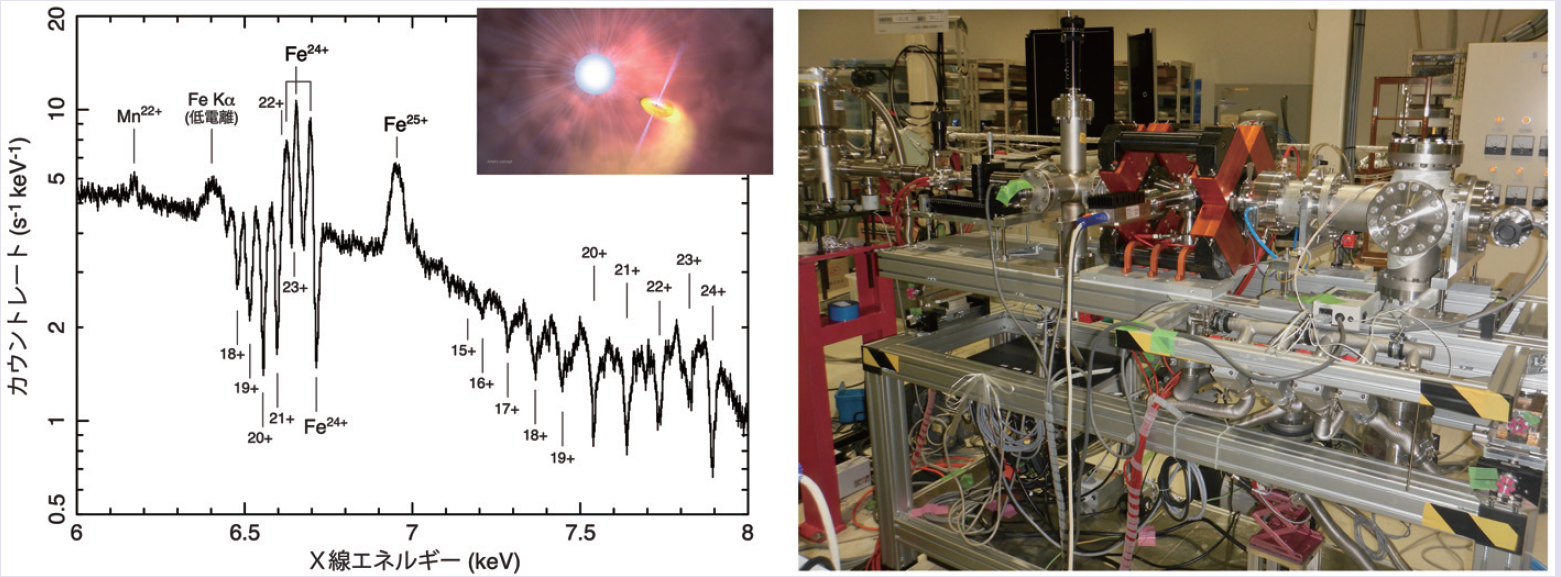Disclaimer: machine translated by DeepL which may contain errors.
The Unexpected Connection between Astronomy and Fusion Science
Hiroyoshi Yamaguchi (Japan Aerospace Exploration Agency / Adjunct Professor, Department of Physics)
To say something that might negate the entire title from the outset, the connection between astronomy and fusion science is actually nothing unexpected. This is because nuclear fusion of hydrogen is taking place at the center of the sun, the celestial body most familiar to us, and fusion science is the study that aims to reproduce this phenomenon on earth to generate energy. The two are originally closely connected. This time, however, I would like to introduce a completely different "connection.
On September 7, 2023, our X-ray astronomy satellite XRISM was launched from the JAXA Tanegashima Space Center. As an example, the spectrum of Cygnus X-3 obtained by XRISM is shown in the figure. This object is a binary star consisting of a massive star and a compact star (black hole or neutron star). The compact star emits intense X-rays in its vicinity, which ionize the surrounding material due to the photoelectric effect. As a result, ions of various valence are produced, and emission and absorption lines are drawn in the spectrum. By examining these spectra in detail, we can determine the density and velocity distribution of the plasma surrounding the binary star.
The Doppler effect is used to measure the velocity. The principle is simple. However, to do this, the energy of the observed emission and absorption lines must be known in a stationary system. In fact, this is not as simple as it seems. The detected ions (Fe15+~24+) are so-called multi-electron atoms, and the Schrodinger equation cannot be solved analytically. Therefore, their atomic structures and transition energies are not known with sufficient accuracy. In addition, the observed absorption lines have a complicated shape. Is this due to the macroscopic velocity structure of the radiation source? Or is it due to the microscopic atomic structure?
To answer these questions, I am working on "creating a universe in the laboratory. I may sound a bit exaggerated, but the point is to create a stationary system of ions found in astronomical observations in a laboratory. By observing the absorption and emission of photons by the ions, we measure their transition energies and transition probabilities. This kind of field is called "laboratory astrophysics. Since the goal is to apply astrophysical data to astronomical observations, the main targets of measurement are inevitably "elements abundant in the universe," such as iron and oxygen.
When I reported on the above efforts at a meeting, a person in the nuclear fusion field asked me, "Can you measure tungsten ions as well? I received a question from a person in the nuclear fusion field: "Can you measure tungsten ions as well? Tungsten is used as a material for fusion reactors because it has the highest melting point among all metals and the lowest thermal expansion coefficient. Even so, tungsten is exposed to temperatures exceeding tens of millions of degrees Celsius, so some of it evaporates and becomes impurities in the fusion plasma. The radiation loss due to these impurities affects the dynamics of the fusion plasma, so the experimental data on tungsten ions will be useful for the design of future fusion reactors, they say. I was moved to learn that this experiment, which I had started for the sake of astronomy, a science that was of no use to anyone, could contribute to nuclear fusion, a field directly related to the future of humankind. It is also interesting to note that it is the basic science of atomic physics that links the two. Of course, the applications of atomic physics are not limited to astronomy and fusion science. The basic subjects that you are now studying as undergraduates are connected to infinite possibilities. I hope you will recognize this once again. When I reported on the above efforts at a meeting, a person in the fusion field asked me, "Can you measure tungsten ions as well?" I received a question from a person in the nuclear fusion field: "Can you measure tungsten ions as well? Tungsten is used as a material for fusion reactors because it has the highest melting point among all metals and the lowest thermal expansion coefficient. Even so, tungsten is exposed to temperatures exceeding tens of millions of degrees Celsius, so some of it evaporates and becomes impurities in the fusion plasma. The radiation loss due to these impurities affects the dynamics of the fusion plasma, so the experimental data on tungsten ions will be useful for the design of future fusion reactors, they say. I was moved to learn that this experiment, which I had started for the sake of astronomy, a science that was of no use to anyone, could contribute to nuclear fusion, a field directly related to the future of humankind. It is also interesting to note that it is the basic science of atomic physics that links the two. Of course, the applications of atomic physics are not limited to astronomy and fusion science. The basic subjects that you are now studying as undergraduates are connected to infinite possibilities. I hope you will recognize this once again.
 |
|||
| (Left) Spectrum of the X-ray binary Cygnus X-3 taken by the X-ray Astronomy Satellite XRISM. An artist's rendition of the object is shown at upper right (credit: NASA's Goddard Space Flight Center). (Right) Plasma experimental device owned by the Institute of Space and Astronautical Science. (Right) Experiments in progress at SPring-8, a large synchrotron radiation facility. Iron ions were generated in the device and their interaction with synchrotron radiation was investigated. | |||


